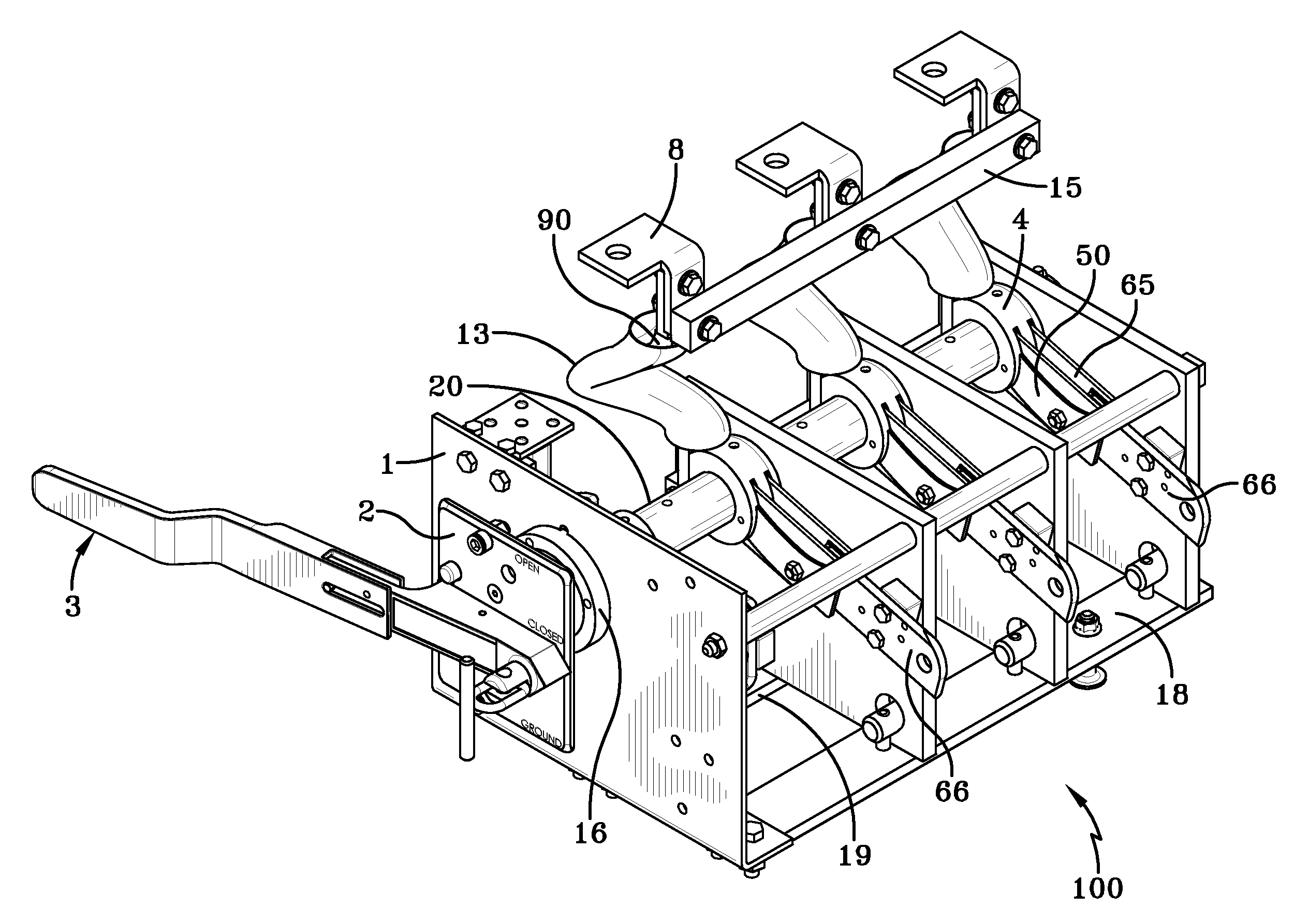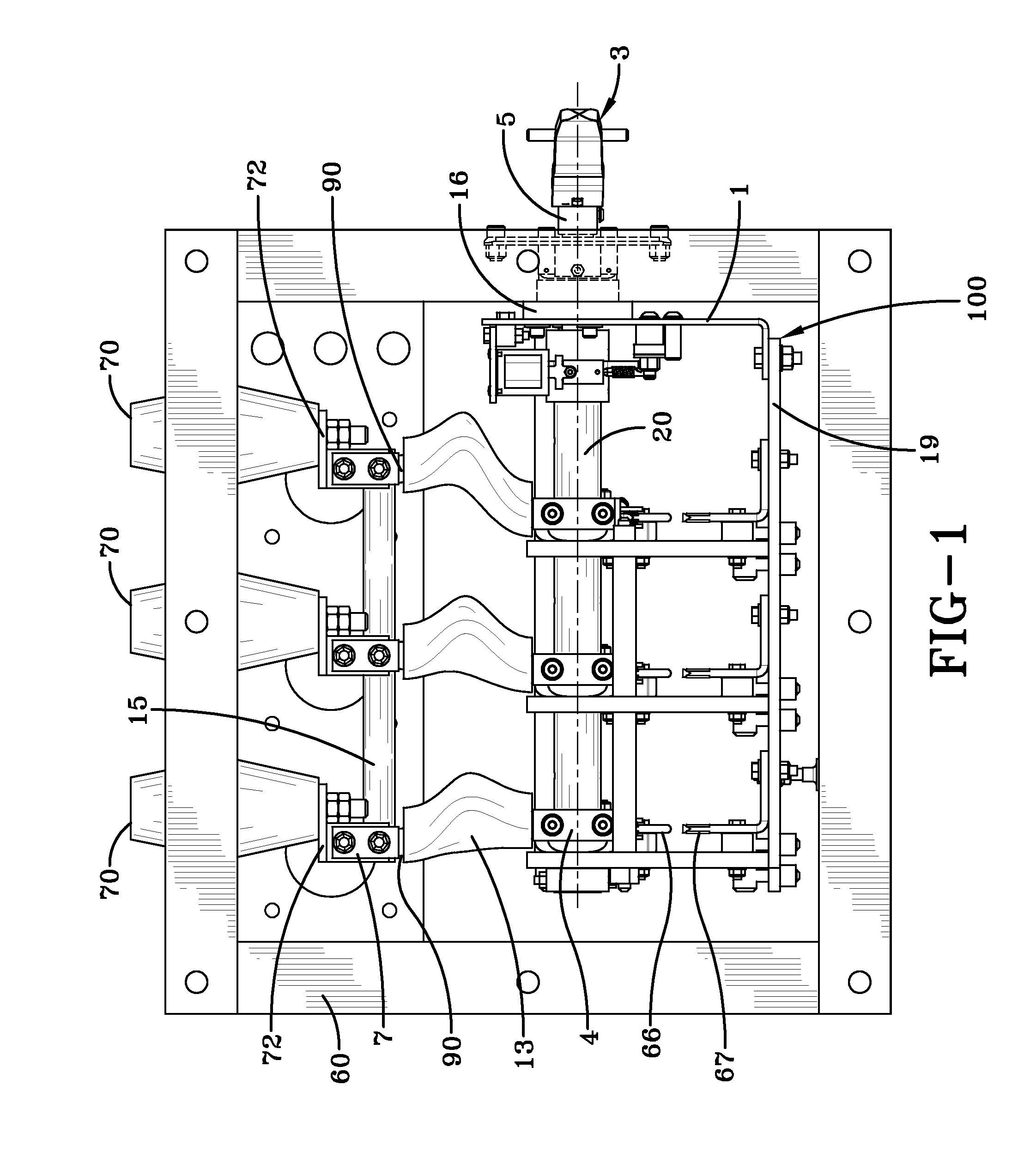For example, fault or other
high current occurrences can weld the switch, or otherwise damage it.
Further, aggressive use by operators or other maintenance workers can also damage the switch by attempting to force it into positions counter to the conventional interlocks installed on such switches.
In some cases, the
interlock mechanism would not hold if high enough torque was applied (typically by using an extension piece of
pipe as an added lever arm).
Correctly and accurately positioning the switch within the liquid containment tank is often difficult, especially when alignment with the exterior operating
handle has to be taken into account.
Further, installation crews that are not familiar with a particular switch manufacturer or switch configuration may very well misalign the switch during installation.
This means that conventional rigid connections between the input contacts of the
rotary switch and the interior contacts on the bushings often do not align properly.
In some cases, therefore, conventional rigid contacts may actually create misalignment of the switch with other elements (such as the liquid containment tank grounding connections, the liquid-tight gland, and the external
handle), so that both the safety and the
operability of the switch is compromised.
Further, when mounting a large electrical device to be grounded (such as a switch) within a liquid containment tank or
chassis, which is also grounded, there can be other difficulties.
Very often connection between the electrical device and the
chassis or liquid containment tank is compromised so that a
high resistance ground might develop between the liquid containment tank and the electrical device.
Under fault conditions, a
high resistance or otherwise faulty ground connection anywhere between the switch and the liquid containment tank (as well as between the liquid containment tank and the system ground) can lead to local or general destruction of the electrical system.
Further yet, if the switch has become misaligned within the liquid containment tank, pre-formed ground connections between the switch and the liquid containment tank often become bent, crimped, or stressed so that it is difficult to make a good ground connection between the liquid containment tank and parts of the switch that are meant to be grounded.
Once the questionable connection is made, mechanical and electrical stresses will tend to degrade the connection even further.
Very often, installers simply do not make the best practical ground connections, even when provided with explicit instructions.
This is especially true if an easy fit cannot be arranged between the interior bushings, the switch terminals, and the pre-configured connectors to be attached therebetween.
Very often, the placement of the switch within the liquid containment tank results in a situation where the switch input contacts do not align properly with the
bushing contacts.
This often results in an effort by the installers to reconfigure rigid connectors between the two, often resulting in the degradation of the connecting links or the connections between the connecting pads or terminals.
At high-voltages and high currents, any compromise of connections at any point can result in substantial deterioration and even dangerous conditions.
Difficulties in making accurate or secure electrical connections can be exacerbated by difficulties in aligning the switch shaft, which is interior to the insulating liquid-filled tank and the external
handle.
If such an error is not readily detected and corrected, the switch can be misused or can malfunction in any number of different ways.
Even when explicit instructions are provided, installers can still misinterpret them, or simply ignore them, aligning the operating handle with the rotation of the switch
drive shaft in any way that seems most convenient at the time.
All too often, it has been discovered that when dealing with installing contractors, the
assembly or installation of high-voltage switch gear has to be rendered as “foolproof.”
As additional background in this case, conventional high voltage grounding switch designs usually include “
heel contacts.” Moreover, there are inherent difficulties with this conventional type of
rotary switch connection.
Firstly, a great deal of pressure must be used to insure a proper high-voltage connection between the rotary shaft of the switch and the “
heel contact.” This means that greater torque is necessary to simply operate the switch.
Conventional “
heel contacts” are rigid in nature, making alignment with the contact points of the incoming bushings difficult.
This in turn, leads to difficulties in aligning the switch shaft with the external operating handle.
All of this increases the difficulty of aligning the output contacts of the switch with the output contacts on the liquid containment tank, which is inherently exacerbated by the tendency of some installers to simply force the various pieces to fit in the most expedient manner available.
The greater torque required by the “heel contacts” means that the amount of torque needed to simply move the switch from a connected position to an open position becomes far more difficult.
Further, if the switch blades have an extremely tight contact with the output or secondary contacts of the switch, opening the switch may become extremely difficult.
This is still further complicated by the fact that indoor vaults (where such switches are usually mounted) are already as compact as designers can make them.
When such
welding occurs, there is usually no way to break the “heel contacts” free from the shaft.
This normally results in the necessity of scrapping the entire switch.
As such, the “heel contacts” constitute the weakest part of the switch gear arrangement, while also constituting a part that is virtually impossible to repair without replacing the entirety of the switch.
From an economic standpoint, this can be disastrous for operation of the system.
Still other problems with existing grounding switches often include the switch handle.
More specifically, limited vault space for the mounting and installation of the subject grounding switches usually leads to foreshortened operating handles so that the switches can be more easily placed within the
confined space.
Unfortunately, if a switch proves to be inconveniently confined in a tight
workspace for the operating staff, the standard, simple and expedient step to more easily operate the handle is to slip a long
pipe over the handle in order to provide far more torque.
Unfortunately, this often used technique often provides more torque than the switch components can tolerate and damage very often occurs.
Also, as a result of the increased torque required by the “heel contacts”, the connection between the switch blades and the secondary output connections on the switch may not be as tight as desired.
Increasing the tension of the switch blades with the secondary contacts may render the switch very difficult to operate and even more subject to accidental damage.
On the other hand, relatively loose contact between the switch blade and the secondary switch connections that interact with the blades when the switch is closed, may have disastrous effects under fault conditions.
Under such conditions, there is a tendency for “blow-off” to occur.
When this does happen, the switch opens, often destructively.
This can create serious problems with the overall system, as well as creating opportunities for additional faults due to broken parts of the switch blades being randomly propelled through the insulting liquid.
Unfortunately, these enhanced and
safer switches must still fit into the original vault spaces designed for the earlier, less robust switches.
Of necessity, for example, the size of containment tanks for upgraded switches may be difficult to change due to space limitations and outside confinements.
Further, the revised standards do not specify how all of the new requirements are to be carried out.
 Login to View More
Login to View More  Login to View More
Login to View More 


